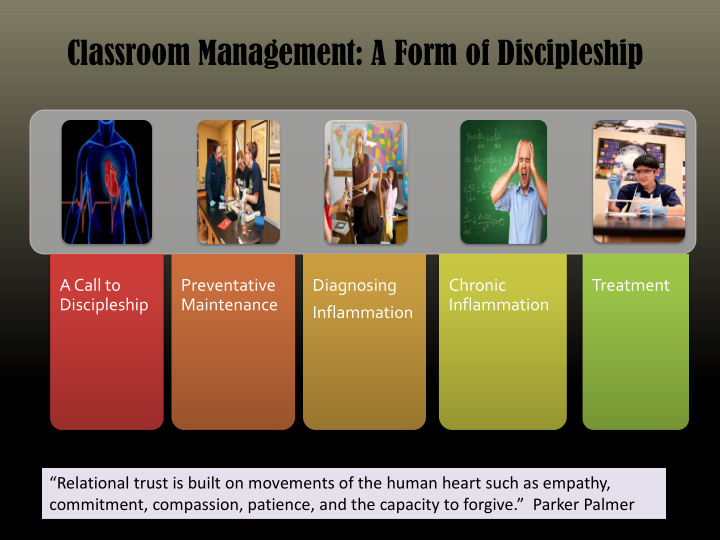



Classroom Management: A Form of Discipleship A Call to Preventative Diagnosing Chronic Treatment Discipleship Maintenance Inflammation Inflammation “Relational trust is built on movements of the human heart such as empathy, commitment, compassion, patience, and the capacity to forgive.” Parker Palmer
WHAT IS CLASSROOM MANAGEMENT? STANDARD DEFINITION Simply put, classroom management refers to the wide variety of skills and techniques that teachers use to ensure that their classroom runs smoothly, without disruptive behavior from students. It boils down to having a structured learning environment with clear expectations that promote learning as well as consequences that diminish or eliminate behaviors that get in the way of learning. Successful classroom management stems from a teacher creating an atmosphere where a student’s heart and mind can develop.
A CALL TO DISCIPLESHIP Use Romans 12:9-21; 14:1-7; 15:5-7; Matt 28:18-20; Luke 6:40 as a guide
VETERAN TEACHER’S TOP 5 95 YEARS OF COMBINED TEACHING EXPERIENCE 1. Mutual love and respect. When students feel known and respected, they almost always respond in kind. Get to know them 2. Model what you expect. I can’t expect my students to behave if I am not prepared and doing my job well. Be humble if you expect humility. Be passionate. 3. Don’t surprise. Consistency in class routines and grading builds trust. Inconsistency brings resentment. 4. Pray for Your Students Daily. 5. Teach Bell to Bell. Avoid the arbitrary (random tangents; unspecified path); Fill Every Hour.
TEACHER-STUDENT RELATIONSHIP-O-METER WHERE IS THE ARROW POINTING? Steadfast, warm, assertive, organized Rules, content, Smart, yet Cool teacher/mentor exordium, Contrarian books, Finals Happy Kids, Drill Sargent but strong Happy Parents! content knowledge Comedian w/ some Choleric in need of fun facts Metamucil or more coffee Grumpy Total Bros/Sisters/ Curmudgeon Besties
PREVENTATIVE • Pray with Intentionality • Be You • Lay the Foundation for Cooperation • Peers are a powerful influence • Build Relationships • Points of Contact • Parents • Excite the students — Invoke Wonder • Look for “Coaching Moments”
WHEN CONFRONTING INFLAMMATION: DISCIPLESHIP MODEL • Shift tones, not temper. Avoid the “People can't pitfalls of anger. blame children for • Public admonishment is fine for fooling around. Kids certain offenses (blurting, disrespect, migrate to the least etc.) effective form of Passivity invites inactivity and • rewards inappropriate behavior. management.” ~ Fred Jones You can’t die on every hill— avoid the • war of attrition. Look at the historical context. This • requires active note keeping. GOAL: Repentance → Forgiveness → Reconciliation → Restoration
DIAGNOSING THE ROOT CAUSE OF INFLAMMATION • The heart of the issue matters more than the infraction itself. • There are usually issues at home that you’re not aware of (Private vs. Public Rebuke). • Observe the visual cues of your students. (nervous twitch, change in posture, etc. ) • Historical Context: Is this behavior in line with what I’ve seen over the past several months? Even good students have bad days.
• How do you know if you’ve hit the discipline “wall?”
SCENARIOS
Recommend
More recommend